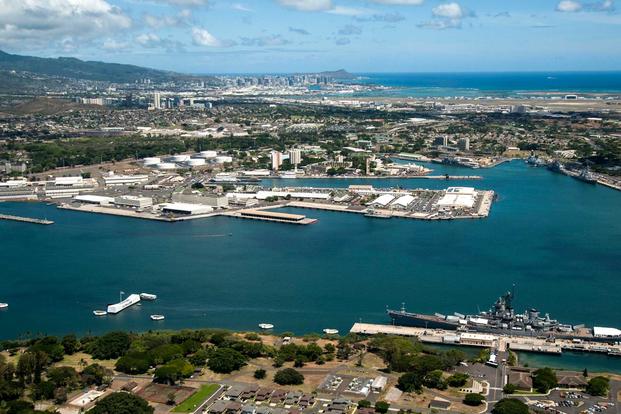The mercury was found last month in an Oahu elementary school sink, not far from another elementary school where high levels of beryllium were detected during large-scale testing of the school’s water system. Navy in Honolulu.
The service announced Friday that a March 16 sample taken from Pearl Harbor Kai Elementary School contained mercury levels nearly double the limit set by the Safe Drinking Water Act.
The sample was taken from an indoor sink located in an administration building “not regularly used by students”, according to the Navy, and isolated from the sink.
Read more : Judge blocks Air Force discipline over vaccine objections
News of the mercury discovery was followed Saturday by an announcement from the Navy that “no more than” 30 gallons of fuel and water had spilled at the Red Hill Fuel Complex. The accidental release happened as workers were removing water from fuel tanks, a process known as “dehydration”.
Navy personnel halted the process and the Hawaii Department of Health was called in to oversee the cleanup, according to a news release from the service.
Both incidents come amid extensive water testing around the Navy’s Red Hill installation after a spill contaminated a water well last November, displacing more than 4,000 service members and their families. and sickening about 6,000.
The Navy shut down the Red Hill facility and spent months flushing and testing the water system, sampling about 5% of homes in affected neighborhoods. The service said it would test about 10% of homes every six months for the next two years.
The discovery of mercury in the school sink is likely related to a contaminated faucet, as no other water samples taken at the school or nearby buildings contained mercury. The faucet has since been replaced with new water safety results pending, according to the Navy.
In addition to mercury, test results revealed elevated levels of other contaminants, including:
- Beryllium in an outdoor sink at Pearl Harbor Elementary School, at a level one quarter above the limit accepted by the Hawaii Department of Health. The metal is frequently used in the aerospace industry to create alloys and make gears, cogs, springs, airplanes, satellites and more.
- Lead levels three times the legal limit in a laundry sink – also not used by children – at the Pier Side Child Development Center.
- Levels of an organic compound known as DEHP seven times the permitted amount have been detected in a vacant house on the base. The same chemical, which is often added to plastics to make them flexible, was found at significantly higher rates in non-residential buildings in three areas, including the Catlin Park and Radford Terrace neighborhoods and the Pearl shipyard Harbour.
- Oil contamination in a home in the Halsey Terrace neighborhood that was tested at levels of 460 parts per billion, double the health department’s accepted level of 211 parts per billion.
Although there have been few studies on the health effects of long-term exposure to petroleum products in humans, mercury exposure, whether chronic or acute, can damage the system. nervous, causing tremors, mood swings or irritability; cognitive impairment; insomnia,; headache; and more.
Lead poisoning, especially in children, can impair the development of the brain and other organs, causing developmental and intellectual delays and disorders, including reduced intellectual capacity and behavioral problems.
The Hawaii Department of Health announced on March 18 that tap water in all residential areas served by the Navy Water System at Pearl Harbor was safe to use and drink, after extensive rinsing of the service.
“In the name of the secretary [Lloyd] Austin, we are incredibly proud of the diligent work done by the Interagency Drinking Water System team to restore safe drinking water as well as the hundreds of volunteers and the many people from Hawaii who have helped our displaced families during this unfortunate situation,” Secretary of the Navy Carlos Del Toro said in a press release after the announcement.
Families remain wary, however, with some paying for third-party testing or asking the Navy to test all individual homes to ensure the water is safe.
Navy wife Lauren Wright returned to her home in the Radford Terrace neighborhood last month to find her water heater destroyed by contamination and the water showing a visible splinter.
Even after the system’s second flush in mid-March, the smell “comes and goes,” as does the shine, she told Military.com.
At the end of March, the family was still using a camping shower with water from outside sources and filtering all of its water.
“We just want options and the truth,” Wright said. “I said to my son, ‘Take a quick shower, that’s for sure’, and he said, ‘But I don’t want my skin to fall off.'”
Following the original fuel spill, the Navy established a 24-hour crisis response team through Joint Base Pearl Harbor-Hickam’s Emergency Operations Center, according to the service.
In his March statement, Del Toro encouraged families to contact any concerns or issues about their water immediately.
“We all recognize that this has been a hardship for these families and want to thank them again for their patience and resilience,” Del Toro said. “Our priority will continue to be their safety and getting them back to a new, better normal.”
— Patricia Kime can be reached at Patricia.Kime@Military.com. Follow her on Twitter @patriciakime.
Related: ‘We’ve put you in a dangerous situation’: Top Navy officials apologize for contaminated water at Pearl Harbor
Show full article
© Copyright 2022 Military.com. All rights reserved. This material may not be published, broadcast, rewritten or redistributed.

